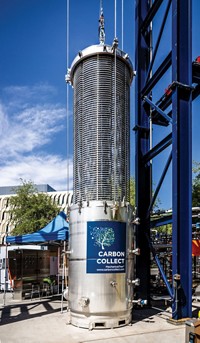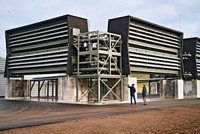Advertisement
Grab your lab coat. Let's get started
Welcome!
Welcome!
Create an account below to get 6 C&EN articles per month, receive newsletters and more - all free.
It seems this is your first time logging in online. Please enter the following information to continue.
As an ACS member you automatically get access to this site. All we need is few more details to create your reading experience.
Not you? Sign in with a different account.
Not you? Sign in with a different account.
ERROR 1
ERROR 1
ERROR 2
ERROR 2
ERROR 2
ERROR 2
ERROR 2
Password and Confirm password must match.
If you have an ACS member number, please enter it here so we can link this account to your membership. (optional)
ERROR 2
ACS values your privacy. By submitting your information, you are gaining access to C&EN and subscribing to our weekly newsletter. We use the information you provide to make your reading experience better, and we will never sell your data to third party members.
Greenhouse Gases
Biden picks two DAC hubs for federal funding
Texas and Louisiana projects to capture CO2 from the air will get a combined $1.2 billion
by Craig Bettenhausen
August 14, 2023

The Joe Biden administration has picked the first two regional direct air capture (DAC) hubs to receive implementation funding from the federal government. Projects near Corpus Christi, Texas, and Lake Charles, Louisiana, will split $1.2 billion from the 2021 federal infrastructure bill. The US Department of Energy (DOE) also selected 19 other DAC projects for smaller amounts of funding in support of early-stage engineering and design work.
Each facility is intended to pull 1 million metric tons (t) of CO2 from the ambient air and inject the greenhouse gas underground or under the ocean floor for permanent disposal. A number of DAC plants are in planning and construction stages worldwide, but the technology is unproven at commercial scale.
The South Texas DAC Hub is led by 1PointFive, a subsidiary of Occidental Petroleum. It will use CO2 scrubbing technology from the start-up Carbon Engineering involving a set of chemical loops that separate CO2 from the air (Joule 2018, DOI: 10.1016/j.joule.2018.05.006).
In the process, giant fans blow air over a 3D plastic mesh dripping with potassium hydroxide (KOH), which reacts with CO2 to form potassium carbonate (K2CO3). The K2CO3 solution moves into a pellet reactor, where it encounters calcium hydroxide (Ca(OH)2). The resulting calcium carbonate (CaCO3) falls out as a solid, regenerating the original KOH solution, which heads back to the start of the process. The firm then heats CaCO3 in a separate chamber to yield pure CO2 and regenerate the Ca(OH)2.
Carbon Engineering and 1PointFive have already broken ground on a similarly-sized DAC plant in west Texas.
Four days after the DOE awarded Occidental and Carbon Engineering funds, Occidental agreed to purchase Carbon Engineering for $1.1 billion.
The Louisiana site, Project Cypress, will be led by scientific development company Battelle and use technologies from two DAC firms, Climeworks and Heirloom Carbon Technologies. Climeworks uses solid-state sorbents based on amine chemistry to capture CO2 from the air. When the sorbent is full, the unit closes and removes the concentrated CO2 using heat and vacuum. Heirloom’s approach captures CO2 by reacting it with calcium oxide (CaO) to form CaCO3, which it then heats to release the CO2 and regenerate CaO. The DOE’s announcement did not specify how the two technologies will be combined.
Climeworks’ Orca plant in Iceland can capture 4,000 t per year and is the largest DAC plant in the world. The firm is building a second plant four times as large.
Carbon capture advocates praised the administration’s decision. “Today’s announcement is a shot in the arm for the development of this nascent, but critical climate mitigation technology and will support a variety of approaches across three phases of technical maturity within the DAC value chain,” Madelyn Morrison, government affairs manager for the nonprofit Carbon Capture Coalition, says in a statement. “The implementation of these federal funds is a culmination of a years-long effort to help ensure carbon management technologies, and in this instance, DAC technologies specifically, can deploy at the pace and scale necessary to achieve climate targets.”
"Government funding is going to burn capital by default, and that’s OK, but we should burn it wisely," says Darius Mortazavi, an independent analyst covering the chemical industry. “DAC has wildly uncertain long-term economics. And other companies, who achieve the same end but by different means, struggle to capitalize,” he says. For example, emerging companies converting waste biomass into durable goods and chemical feedstocks have struggled to win investment and subsidies.
Nikki Batchelor, executive director of XPRIZE Carbon Removal, emphasizes that DAC and other methods to remove legacy CO2 from the atmosphere are needed as part of humanity’s way out of climate change disaster. “In addition to radical emissions reductions, carbon removal will be an important piece of the overall climate solutions portfolio and our journey to reach net zero emissions by 2050,” she says.
UPDATE:
This story was updated on Aug. 16, 2023, to incorporate information about Occidental Petroleum's agreement to purchase Carbon Engineering and comments by Darius Mortazavi.





Join the conversation
Contact the reporter
Submit a Letter to the Editor for publication
Engage with us on Twitter